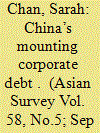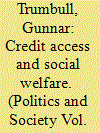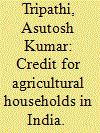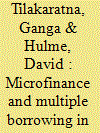|
|
|
Sort Order |
|
|
|
Items / Page
|
|
|
|
|
|
|
| Srl | Item |
| 1 |
ID:
161401


|
|
|
|
|
| Summary/Abstract |
China’s corporate debt has risen sharply since the 2008–09 global financial crisis, although the pace of growth has somewhat moderated due to the authorities’ recent financial deleveraging efforts and regulatory tightening. To address the surging debt problem and elevated corporate leverage, comprehensive structural reforms in the corporate, financial, and fiscal sectors are necessary.
|
|
|
|
|
|
|
|
|
|
|
|
|
|
|
|
| 2 |
ID:
110868


|
|
|
|
|
| Publication |
2012.
|
| Summary/Abstract |
Research into the causes of the 2008 financial crisis has drawn attention to a link between growing income inequality in the United States and high household indebtedness. Most accounts trace the U.S. idea of credit-as-welfare to the period of wage stagnation and welfare retrenchment that began in the early 1970s. Using France as a comparison case, I argue that the link between credit and welfare was not unique to the United States. Indeed, U.S. charitable lending institutions that emerged at the beginning of the twentieth century were modeled in part on older French financial institutions. Three historical factors drove U.S. lenders and policymakers to push for expanded credit access for the working class. First, welfare reformers in the interwar period embraced private credit as an alternative to an expansive welfare state. Second, U.S. organized labor in the wake of World War II embraced credit access as a means to sustain industrial employment and finance strike actions. Third, commercial banks in the 1950s began offering revolving credit accounts as a means to attract new depositors at a time when banking regulation restricted the interest they could offer on deposits.
|
|
|
|
|
|
|
|
|
|
|
|
|
|
|
|
| 3 |
ID:
155168


|
|
|
|
|
| Summary/Abstract |
Why has the share of non-institutional finance sources for agricultural households not come down between 2002 and 2012? Is the dependency on non-institutional sources the same across farm size classes? Who are the major beneficiaries of the revival in agricultural credit in the 2000s? Are larger farmers becoming more productive and commercial thus requiring higher levels of credit? Are small farms becoming unviable, making it difficult for banks to finance them? This paper examines these issues empirically based on data from the Situation Assessment Survey (SAS) of Agricultural households and the All India Debt and Investment Survey (AIDIS) conducted by the National Sample Survey Organization (NSSO) in its 59th (i.e. 2003) and 70th round (i.e. 2013) and various publications from the Reserve Bank of India (RBI).
|
|
|
|
|
|
|
|
|
|
|
|
|
|
|
|
| 4 |
ID:
105939


|
|
|
|
|
| Publication |
2011.
|
| Summary/Abstract |
Global governance links security and finance in four important ways. First, the combined effect of the financial crisis and the global 'war on terror' has been an increasingly explicit merging of finance and security concerns. Second, security and finance were arguably closely linked in the rise of the modern form of government as far back as the late 17th century, a relation still evident in the form of 'government securities' such as bonds and treasuries, which in 2010 rose to new prominence in the various sovereign debt crises of the Eurozone. Third, a considerable literature has shown that finance and security share a claim to universal applicability in (all) other social spheres, resulting in various forms of financialization and securitization ( Martin, 2002; Langley, 2007; Buzan et al., 1998). Finally, not only have the liberal strategies of finance and security converged in a common vocabulary and epistemology of risk (management), but this technology of governing the future is currently undergoing a critical epistemic transformation that in turn implies finance and security in new relationships.
|
|
|
|
|
|
|
|
|
|
|
|
|
|
|
|
| 5 |
ID:
001110


|
|
|
|
|
| Publication |
New Delhi, Madhyam Books, 1991.
|
| Description |
154p.
|
| Standard Number |
8186816046
|
|
|
|
|
|
|
|
|
|
|
|
Copies: C:1/I:0,R:0,Q:0
Circulation
| Accession# | Call# | Current Location | Status | Policy | Location |
| 040593 | 332.7/PAY 040593 | Main | On Shelf | General | |
|
|
|
|
| 6 |
ID:
139481


|
|
|
|
|
| Summary/Abstract |
In recent years, there has been an increase in multiple borrowing in the microfinance sector in Sri Lanka, while many microfinance institutions (MFIs) have experienced high levels of borrower turnover, deteriorating portfolio quality and weak financial performance. This has raised concerns about the microfinance sector. However, the debt levels for the majority of borrowers remain at moderate levels, while a number of mitigating factors such as mobilization of borrower savings by MFIs, wide use of pawning among clients and a reduction in donor funds to the sector suggest that a microcredit bubble in Sri Lanka is unlikely in the near future.
|
|
|
|
|
|
|
|
|
|
|
|
|
|
|
|
| 7 |
ID:
131246


|
|
|
|
|
| Publication |
2014.
|
| Summary/Abstract |
The Self-Help Group-Bank Linkage Programme (SHG-BLP) was designed with the objective of bridging the prevailing gap in the financial network and spreading banking facilities to the poor in rural and urban areas. This paper examines the progress of SHG-BLP over the last two decades in terms of: (a) the outreach of SHG-BLP; (b) spatial disparity in SHG-BLP; (c) SHG spread with respect to banking and socio-economic indicators; and (d) potential vis-à-vis achievement under the programme in terms of coverage of rural poor population.
|
|
|
|
|
|
|
|
|
|
|
|
|
|
|
|
| 8 |
ID:
181435


|
|
|
|
|
| Summary/Abstract |
Despite the potential benefits to human health and greenhouse gas mitigation, the uptake of biogas plants in Nepal and other developing countries has been less than optimal. We investigate the potential to stimulate the market for biogas plants through the distribution of environmental income generated from carbon credits. While previously identified in the literature, this has received limited experimental testing in the context of rural households in developing countries. We first use contingent valuation to assess willingness to pay for domestic biogas plants. Using Heckman selection models, we then examine how the provision of carbon revenue earnings influences household willingness to purchase in the absence of a subsidy. We find that households are willing to pay on average US $361.54 for a biogas digester, which is less than full market price of US $433.79, but higher than the current market price net of government subsidy. Household willingness to purchase is influenced by access to environmental income for those not initially in the market, but has no effect on those initially willing to purchase a biogas plant. Our findings suggest that the provision of environmental income has the potential to lead to more rapid and widespread adoption of biogas plants.
|
|
|
|
|
|
|
|
|
|
|
|
|
|
|
|
|
|
|
|
|